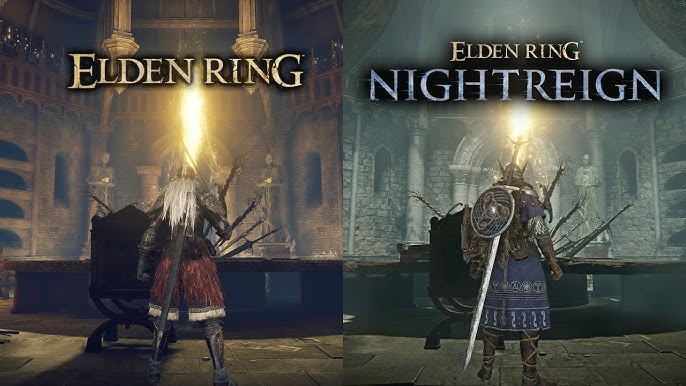Elden Ring Nightreign vs. Elden Ring – What are the Differences?
If you've ever wandered the haunting beauty of the Lands Between in Elden Ring, then you already know how deep, immersive, and punishingly fun FromSoftware's world can be. But now, with Elden Ring Nightreign launching on May 30th, a lot of longtime fans are asking: Elden Ring Nightreign vs. Elden Ring – what’s the different?
FromSoftware may have used the same dark fantasy universe, but make no mistake — Elden Ring Nightreign is not just DLC or a reskin of the original. It’s a co-op rogue-like experience with fundamentally different mechanics, pacing, and goals. Whether you're a solo Tarnished or diving in with friends, there's a lot to unpack here.
Oh, and before we get deep into the weeds, if you're gearing up and want cheap Elden Ring runes, PVPBank is a solid option to give you a little edge without grinding through hours of mobs. Okay, let's get into the gritty details.
Different World, Same Universe
So first up — the setting. Elden Ring Nightreign doesn’t take place in the Lands Between. Instead, you’re in Limveld, a new region that exists parallel to the original story. There’s no Shattering, no quest to become Elden Lord. Think of it as a parallel narrative, same universe, but with a whole new problem to deal with: the rise of the Nightlords.
Limveld is smaller than the original open world — more comparable in scale to Limgrave than the full Lands Between. But don’t mistake size for simplicity. While Elden Ring emphasized sprawling exploration and slow-burn lore discovery, Nightreign moves fast, keeps pressure on, and resets you every run.
Rogue-like vs. Open World Adventure
Here’s the big one. The main difference between Elden Ring Nightreign vs. Elden Ring comes down to structure.
In the base Elden Ring, you’re on a long-term journey. You level up, build a character, collect weapons, and defeat dozens of optional and required bosses. That progression is persistent — what you earn, you keep. Every step matters.
In Nightreign, that’s all thrown out the window. It’s a rogue-like. Each run starts you at level 1. You explore, you loot, you fight — and then a final boss (called a Nightlord) appears to end the run. Weapons, runes, and skills are not permanent, unless you're earning Relics or Murk for meta-progression.
It’s a high-risk, high-reward format that encourages learning on the fly and mastering each Nightfarer class.
Time Pressure and Shifting Terrain
Unlike the more relaxed pace of Elden Ring, where you could get lost for hours in a dungeon or side quest, Nightreign has a ticking clock. Each run lasts three in-game days, with a ring of darkness slowly closing in as time passes. At the end of the third day? You face a Nightlord. Survive or die trying.
Adding to the chaos is the Shifting Earth system. Limveld’s environment procedurally changes — you might stumble upon a lava crater, a horde of elite enemies, or even an event boss that can steal your levels. It keeps you on your toes. This unpredictability is a big part of what sets Elden Ring Nightreign vs. Elden Ring apart.
Multiplayer First, Solo Possible
The original Elden Ring was solo-first, co-op second. You summoned help if needed, but the game was clearly tuned for solo players. Nightreign flips that. This game is co-op first. Up to four players can team up as Nightfarers, and there’s a full revive system (complete with pounding on your buddy to bring them back — weirdly fun).
That said, solo play is still possible, but tougher. Only one character (likely the Revenant) seems to use Spirit Ashes, and the overall difficulty ramps up fast without support.
Remembrances and Character Lore
One of the best parts of Elden Ring was diving into item descriptions, reading cryptic NPC dialogue, and slowly piecing together lore. Nightreign introduces a new system called Remembrances. These unlock character backstories, open up unique encounters, and even launch mini-instances like coliseum duels or boss fights.
It’s lore-driven content, but with gameplay impact. If you like story with your suffering, this is your jam.
Faster Movement, No Fall Damage
Let’s be honest — we’ve all died in Elden Ring because we misjudged a cliff. In Nightreign, that’s no longer a thing. No fall damage. Seriously.
Combine that with faster base movement, cliff-scaling, and the return of Spiritsprings, and you’ve got a more mobile, agile experience. While you won’t have Torrent this time, your character can move through Limveld with real momentum.
Permanent Progress Through Relics and Murk
In classic rogue-like fashion, Nightreign offers permanent upgrades between runs — just not in the form of XP or weapons. Instead, you’re collecting Relics and Murk.
Relics provide passive boosts or modify your abilities — like shorter cooldowns or better healing. Murk is a currency used at the Roundtable Hold vendor to unlock more relics, cosmetics, or “Relic Rites.” It’s a solid system that keeps you improving even if your runs fail.
Bosses vs. Nightlords
This part is fascinating. Elden Ring has some of the best boss design ever — from Radahn to Malenia. In Nightreign, the core bosses are the Nightlords — eight terrifying, unique enemies waiting at the end of each run.
Each Nightlord offers different mechanics. Take Libra, Creature of Night, for example. You can bargain with her for powerful loot, but doing so boosts her difficulty in unknown ways. That’s classic FromSoftware mind games, and it’s glorious.
Online Only
Here’s the deal-breaker for some folks: Elden Ring Nightreign is online-only. Even solo players need to be connected. That’s a bummer for offline fans, but understandable given the game’s co-op structure and procedurally updated world.
If that doesn’t sit right with you, the original Elden Ring is still there, fully playable offline.
Price and Value
Another major difference when comparing Elden Ring Nightreign vs. Elden Ring is the price point. Elden Ring launched at $59.99, with the Shadow of the Erdtree Edition climbing to $79.99.
Nightreign? Just $39.99. And the Deluxe Edition is $54.99. It’s a more accessible entry point, though don’t expect it to be as massive in scale. Still, with tons of replayability and upcoming DLC (likely new Nightfarers, bosses, and gear), it’s a solid value.
Final Thoughts
So, what’s the different between Elden Ring Nightreign vs. Elden Ring? Pretty much everything, besides the art style and lore DNA. One’s a sprawling solo RPG, the other is a fast-paced, multiplayer rogue-like with shifting maps, meta-progression, and some wild new mechanics.
Is it better? That depends on what kind of Tarnished you are. But one thing’s for sure — Nightreign isn’t here to replace Elden Ring. It’s here to challenge it in a whole new way.
Whether you're diving into Limveld with a squad or flying solo like a true masochist, there's a whole new world of pain waiting for you. Praise the sun... and prepare to die again.

